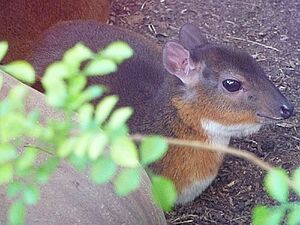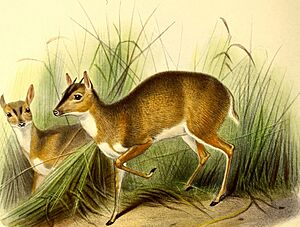Royal antelope facts for kids
Quick facts for kids Royal antelope |
|
|---|---|
 |
|
| An individual at the San Diego Zoo | |
| Conservation status | |
| Scientific classification | |
| Synonyms | |
|
Capra pygmaea Linnaeus, 1758 |
The royal antelope (Neotragus pygmaeus) is an amazing animal from West Africa. It is known as the smallest antelope in the world! A Swedish scientist named Carl Linnaeus first described it in 1758.
This tiny antelope stands only about 25 cm (10 in) tall at the shoulder. It weighs just 2.5–3 kg (5.5–6.6 lb), which is like a small dog. It has long, thin legs, with its back legs being twice as long as its front legs.
Only male royal antelopes have horns. These horns are short, smooth, and spiky. They measure about 2.5–3 cm (0.98–1.18 in) and bend backward. The antelope's fur is soft and can be reddish to golden brown. Its belly is white, which stands out against its colorful coat.
Royal antelopes are usually nocturnal, meaning they are active at night. They are very alert and quick. They mark their areas with dung. These antelopes eat plants, preferring fresh leaves and shoots. Sometimes, they might also eat fruits and mushrooms.
Like some other antelopes, the royal antelope often stays with one partner for life. Both males and females can have babies as early as six months old. Babies are usually born in November and December. Only one small baby is born at a time.
These antelopes like places with lots of fresh, thick bushes and plants. They live in warm, wet forests in West African countries. These include Côte d'Ivoire, Ghana, Guinea, Liberia, and Sierra Leone. The royal antelope is listed as "Least Concern" by the IUCN. This means it is not currently in danger of disappearing. However, their homes are shrinking because of human settlements. Hunting them for meat is also a threat.
Contents
What is a Royal Antelope?
The name "royal antelope" comes from an old story. A merchant named Willem Bosman said that local people called this antelope "the king of the harts." This meant it was seen as the king of all antelopes.
Its scientific name is Neotragus pygmaeus. It belongs to the Neotragus group and the Bovidae family. This family includes animals like cows, goats, and other antelopes. Carl Linnaeus first described it in his book Systema Naturae in 1758.
The name Neotragus comes from two Greek words. "Neos" means "new," and "tragos" means "he-goat." The word pygmaeus also comes from Greek. It means "pygmy" or "fist-sized," which perfectly describes this tiny animal.
How Does the Royal Antelope Look?
The royal antelope is the smallest antelope and the smallest ruminant in the world. Ruminants are animals that chew their cud, like cows. It is also the smallest hoofed animal in Africa.
It stands only about 25 cm (9.8 in) tall at the shoulder. It weighs between 2.5–3 kg (5.5–6.6 lb). Its head and body are usually about 40 cm (16 in) long. Its legs are long and thin, with the back legs being twice as long as the front legs. This makes it look a bit like a hare.
Its thin tail is 5–8 cm (2.0–3.1 in) long. It is white underneath and has a white tuft at the end. Female royal antelopes are a bit bigger than males. Only the males have horns. Their horns are short, smooth spikes, about 2.5–3 cm (1.0–1.2 in) long. They curve backward.
The antelope's fur is soft and can be reddish to golden brown. This color is very different from its white belly. It has a brown band across its chest. A clear reddish-brown collar can be seen on its neck. Its chin and the inside of its legs are also white.
Its face has large, round, dark brown eyes. It has small, see-through ears and a slim snout. Its nose is large and grayish-pink. Compared to another small antelope, Bates's pygmy antelope, the royal antelope has a longer snout and wider lips.
Behavior and Lifestyle
The royal antelope is very alert, so it's hard for scientists to study its behavior. If it senses danger, it quickly hides. It runs away fast if the danger gets too close. It can move very quickly, either by sprinting low to the ground or by making strong leaps. Its powerful back legs help it jump far.
It can jump about 2.8 m (9.2 ft) in one leap. It can also jump as high as 55 centimetres (22 in) off the ground. These antelopes are usually active at night (nocturnal). However, they might also be seen moving around during the day. They usually rest or chew their cud during the day. They mark their territory by leaving dung.
What Do Royal Antelopes Eat?
The royal antelope is an herbivore, meaning it eats plants. It likes small amounts of fresh leaves and shoots. Sometimes, it will also eat fruits and fungi. Even though it's mostly nocturnal, some scientists believe it eats throughout the day. It might also look for food at night.
The royal antelope has a longer snout and wider lips compared to Bates's pygmy antelope. These features mean it can't fully digest tough, woody plants. So, these antelopes often move to new places to find fresh, soft plants to eat.
Reproduction and Life Cycle
Like other small antelopes, the royal antelope often forms a pair and stays with one partner. However, sometimes they might have more than one partner. Both male and female antelopes can start having babies when they are about six months old.
Babies are usually born in November and December. Typically, only one small, delicate baby is born at a time. The baby weighs about 0.8–1 kg (1.8–2.2 lb), which is almost a third of an adult's weight. Young antelopes look similar to adults in color. In captivity, a royal antelope was found to live for about six years and eight months.
Where Do Royal Antelopes Live?
The royal antelope prefers areas with fresh, thick bushes and other plants. It lives in the warm, moist lowland forests of western Africa. These countries include Côte d'Ivoire, Ghana, Guinea, Liberia, and Sierra Leone.
They also live in the edges of forests and in forests that have grown back after being cut down. Their home range stretches from the Kounounkan Massif in southwestern Guinea. It goes through Sierra Leone, Liberia, and Côte d'Ivoire, all the way to the Volta River in Ghana. They can also be found where forests meet savannah habitats in western Africa.
Threats and Conservation
The International Union for the Conservation of Nature and Natural Resources (IUCN) lists the royal antelope as "Least Concern." This means it is not currently at high risk of extinction. In 1999, experts estimated there were about 62,000 royal antelopes. However, this number might be too low.
Their populations are thought to be decreasing. This is because their homes are being destroyed. Also, human settlements are growing. A big threat to these antelopes is hunting for bushmeat, which is meat from wild animals. They are not hunted much in Sierra Leone and Liberia. But in Côte d'Ivoire, they are a main source of bushmeat.
Royal antelopes live in several protected areas. These include Tai National Park and Haut Bandama Fauna and Flora Reserve in Côte d'Ivoire. They are also found in Kakum National Park in Ghana. Other protected homes include Ziama and Diecke Forest Reserves in Guinea. You can also find them in Tiwai Island and Gola Rainforest National Park in Sierra Leone.



